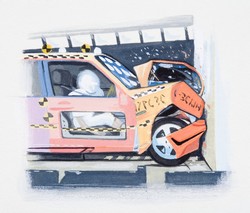Crash modelling tools for cars that run on alternative fuels
The ability to model, simulate and predict the behaviour of ‘Fibre-reinforced polymer’ (FRP) structures had been lagging way behind compared to pressed-steel car bodies, until the EU-funded MATISSE (Modelling and testing for improved safety of key composite structures in alternatively powered vehicles) project stepped in to address the issue. After assessing future crash scenarios involving APVs and analysing hazards for APV occupants, project partners developed and tested modelling techniques for fabric-reinforced structures and thick composites with unidirectional fibres. To validate the modelling approach, the focus was placed on designing and testing two important safety-critical parts of future APVs: ‘Compressed natural gas’ (CNG) fuel tanks and adaptive crash structures. The MATISSE team advanced several methodologies that specifically address difficulties in crash modelling FRP composites compared to metals. It designed, assessed and tested the structural specimens/sub-components and inflators and the high-pressure storage tanks. Criteria for evaluating the safety potential of APVs were defined, and the benefits in terms of cost and weight savings were analysed. Lastly, researchers delivered implementation guidelines and recommendations for the CNG fuel tanks and adaptive crash structures. The guidelines consider the possibility of integrating these two components into one vehicle. Guidelines on fully virtual methods to improve safety were also introduced in order to assess the crashworthiness of the two components. Both sets of guidelines include recommendations on material testing. Additional guidelines were prepared for simulation of the materials in order to obtain appropriate modelling for these components. MATISSE introduced two advanced crash modelling tools that will allow designers to adequately simulate and test various safety aspects of APVs. As a result, car makers will be able to design, build and sell better and safer APVs.
Keywords
Alternatively powered vehicles, fibre-reinforced polymer structures, MATISSE, compressed natural gas fuel tanks, adaptive crash structures







